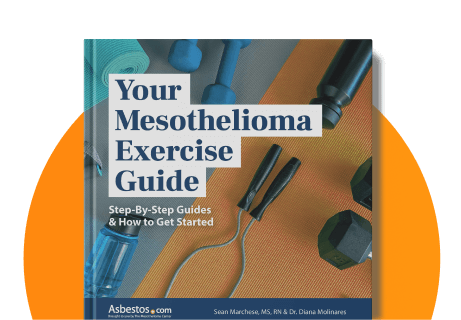Mesothelioma Survivor Discusses Diet and Exercise Challenges and Benefits
Stories from SurvivorsWritten by Travis Rodgers | Edited By Amy Edel

Since being diagnosed with peritoneal mesothelioma nearly a decade ago, Raeleen Minchuk Prokopetz has been passionate about advocacy and raising awareness about the dangers of asbestos. Her own experiences with aggressive surgeries and long-term effects have fueled her commitment to trying to prevent mesothelioma and helping fellow survivors.
Raeleen has worked with WorkSafe Saskatchewan, which shares information about the dangers of asbestos exposure. The Canadian workplace safety and injury prevention group’s mission is to help reduce the number injuries and deaths in the workplace.
Through her work with the organization, she’s shared her mesothelioma story. She’s also emphasized asbestos isn’t just a problem of the past we can forget about now. Because of legacy asbestos in older homes, schools and buildings, as well as automotive parts, machinery and other products, people can still be exposed.
Speaking to the Canadian Broadcasting Corporation in 2019 about possible asbestos exposure while renovating a home, she added people should be aware of the dangers of handling asbestos materials themselves. “They need to know that this is something very serious – not to take on yourself and think, I won’t get sick. It doesn’t take multiple exposures to asbestos to get sick. I would be reaching out and having my house tested before starting renovations.”
Asbestos exposure is the No. 1 cause of workplace-related deaths worldwide. In the U.S. alone there are more than 39,000 occupational asbestos deaths each year.
Raeleen is looking forward to future projects with WorkSafe Saskatchewan soon. She’s also active in support groups and helping fellow survivors on their journeys.
To manage her own health and issues stemming from her past treatments, she says the key is staying active and exercising. She’s also trying a new nutrition plan.
Benefits of Exercise Despite Challenges
Nine years after a peritonectomy and then HIPEC surgery, Raeleen says while she hasn’t had a cancer recurrence, she’s still using medication to help with long-term effects. As a result, she’s now experiencing side effects related to pain medication.
Raeleen shared that she’s on a slow release fentanyl patch. “If I wasn’t on fentanyl, I wouldn’t be able to walk. So that’s one I’ll never get off of. I’ll be on it for the rest of my life,” she told us.
In addition to her patch, she’s also on other medications. Together, she says, they’re causing low blood pressure, tiredness, fatigue and hearing loss in her right ear.
“The major side effect I’ve experienced from fentanyl is my body becoming immune to it,” Raeleen said. “It’s not working the same.”
She’s also experienced sleep issues and has had to take sleep aides to get enough rest. She says these aren’t as helpful anymore either.
“They’re giving me relief, but not the way they used to,” she explained. “Now my pain receptors don’t know what real pain is.”
Raeleen says sometimes she feels like she’s coercing her muscles to work. On rainy days she says it can feel like severe rheumatoid arthritis.
Exercise has been more of a challenge recently. Raeleen’s lung collapsed last September and she recently recovered from bouts of pneumonia. In 2016 and 2017 she walked marathons with her son, but says she wouldn’t be able to do that today without taking several breaks. However, she says she works to stay active and does feel that doing what she can helps improve her overall health.
“I go walking every day. I have two dogs that are more than 100 lbs. and they have to get out. I’m very active. A lot of people don’t even believe it when I tell them I’m a cancer patient,” Raeleen shared.
Oncologists say exercise for mesothelioma is important during treatment and recovery. Keeping active can help increase strength, improve fatigue, boost energy and even improve mood and mental health.
Mesothelioma patients should avoid high impact intense cardiovascular workouts. They should focus on low impact activities like walking, swimming and lightweight strength training.

Access safe, effective exercises to enhance your well-being and improve your quality of life.
Get Your Free GuideMesothelioma Nutrition and Weight Loss Challenges
Since Raeleen’s mesothelioma surgeries, she’s been dealing with severe weight loss. She says her weight fluctuates.
To help manage her weight, she took part in a specially designed nutrition program for gaining weight. The program was successful, helping her gain 40 lbs. in a couple of months.
“My diet is high protein, high calorie and low fiber,” she shares. “I get to eat everything you’re not supposed to eat – lots of pasta, lots of carbs and lots of donuts.”
Raeleen adds, “But there are certain things I can’t have. I can’t drink milk. I can’t drink pop. I can’t drink sugary juices.”
Nutrition for mesothelioma is key for survivors. A healthy mesothelioma diet can help people keep up their strength and energy to undergo aggressive treatments, fight infections and stay active.
Raeleen says no matter what challenges are in her way, she’ll continue accomplishing new goals and reaching important milestones in her life. She still travels and is opening a new business – a golf simulation sports lounge – soon.
Raeleen credits her sons and her granddaughter as her constant inspiration. She says they keep her moving forward no matter what challenges are ahead.






